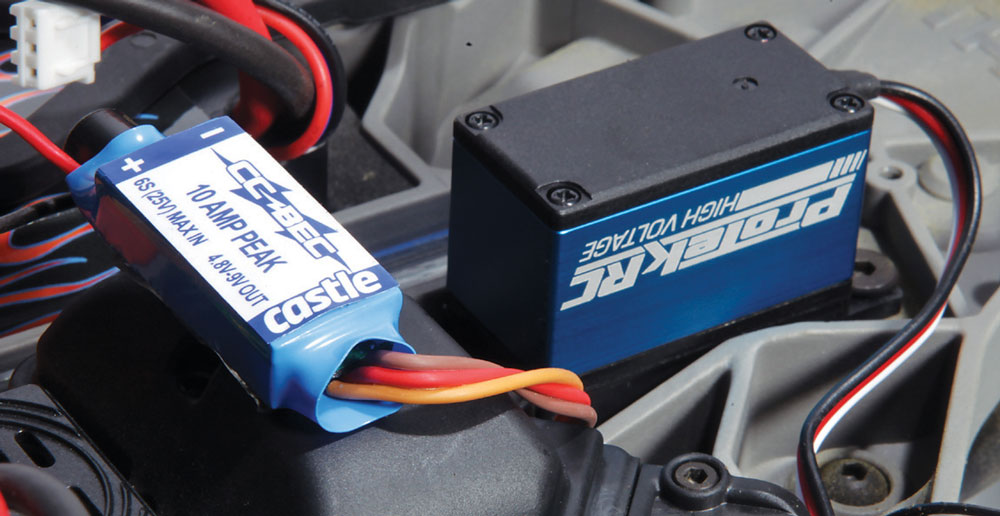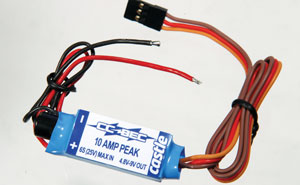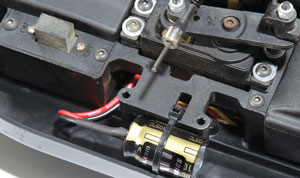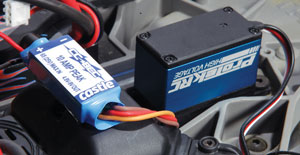Let’s take a look at a very misunderstood part of RC cars and trucks, the BEC of your electronic speed control. This part performs an important function so understanding how it works can help you keep your electronics in good shape and avoid excessive battery drain.

Words: Charlie Suangka

BEC STANDS FOR “BATTERY ELIMINATION CIRCUITRY”
You see, back in the old days of horse-drawn RC cars, receivers and servos operated at lower voltage than the rest of the vehicle and needed their own special battery pack.
When electronic speed controls came along, a circuit inside the BEC dropped the main battery voltage down to a level the receiver and servo could use.
This circuit eliminated the need, for …wait for it….a battery. The BEC was born.
SO WHAT DOES IT DO?
BECs are responsible for dropping the main battery voltage down to that of the radio gear. The bigger the step-down in voltage, the harder the BEC’s job is.
A BEC is very much a voltage regulator and voltage regulators have limitations as to how much power or current they can accommodate. The better the BEC, the stronger it will be and the longer it will maintain the same level of performance as the temperature increases.
A better BEC stays more consistent as it heats up and can maintain operation for the duration of your runs.

IS YOUR SERVO STRAINING YOUR BEC?
Lately, vehicles have more traction, are going faster, handle better, and in some cases weigh more than in years past. The steering department has taken a lot of the focus of upgraders, and the search for the most powerful servo has erupted into a no-holds barred battle of servo manufacturers, many of whom offer servos with astronomical power claims.
This simply means that the servos “use” a lot of power as well. Most of these servos are geared toward use with a receiver battery pack which has unlimited power capabilities when compared to a BEC device.
This generation of servos has caused a ruckus in all areas of RC. Folks are seeing strange system shut-downs, missed laps from the transponders, inconsistent servo power and overheating ESC’s even when the motor gearing is correct and motor temps are reasonable.
Many of these issues stem from the fact that the servo is loading the BEC up and making it run a bit hotter than normal. The BEC is also responsible for other duties in the brain of your ESC, so it’s possible that these other features will malfunction.
WHY YOU SHOULD USE A CAPACITOR
Another common part you’ll see floating around the shelves of any good Pro Shop or top racer’s tool box is the mysterious “Receiver Filter Capacitor”, “Glitch Buster”, “RX Cap”, “Voltage Smoothing Capacitor” or any other fun marketing name.
These capacitors are very simply a boost tank for your servo to run from. As the servo moves it will spike loads to the BEC. The capacitor helps the BEC cope with these loads, often completely resolving problems.
The caps at some tracks can be found in every single vehicle. For the cost, they are worth running. Servo performance is increased and your ESC will run cooler. It’s a fact!
WHY YOU SHOULD USE AN EXTERNAL BEC
External BEC’s are being seen more and more as well. Another “device” to install or solder into your vehicle can seem like the last thing you’d want, but there are some benefits to be had.
The external BEC will run cooler than the ESC’s internal BEC, and your ESC will also run cooler; always good things.
The external BEC remaining cooler means your servo and transponder will run better through the run; giving you consistent steering and no missed laps. The ESC’s internal BEC will now only have to take care of its internal jobs, which means less for the ESC to worry about!

TIPS TO PREVENT SYSTEM STRAIN
Disconnect the linkage from the servo and make sure your steering moves freely and easily through the entire suspension range and throw.
Set your trim first, and then set your steering EPA. So many racers do this wrong and it can have very ill effects on your servos.
Quadruple check that your servos do not buzz or hum in protest when you are at full lock in either steering direction. This alone can overheat a normal setup and damage the servo very quickly.
Keep the servo wires in good shape, as well as the ESC’s receiver harness. Those are the wires that power these hungry devices directly.
REDUCE LOAD FROM THE FAN
Most fan plugs run directly from the BEC voltage so they can be operated with your ESC’s on/off switch. This is simple and clean. However, although the fan is small, it does drain power that adds to the load on the BEC.
A simple way to reduce this load is to connect your fan directly to the main battery leads. This is easy to do on 2S setups, but it’s not always possible for higher voltage packs with “standard” RC fans. The fan will run faster and run “all the time.” This means when the races are over and you’re out turn-marshaling, your “hot electronics” get the cool vibes from your fan. Bonus!
WRAP-UP
Some servos draw enough power that it would be safe to say they are starting to effect vehicle runtimes. Choose wisely as adding complexity to your vehicle just for the sake of “overkill” is not always a good idea. As you add devices, you are adding complexity and the possibility of items either failing or simply being installed incorrectly. Choosing components suited for each other’s capabilities is the key to a successful setup!
 RC Driver The Best In RC Car & Truck News, Reviews & Video
RC Driver The Best In RC Car & Truck News, Reviews & Video 







